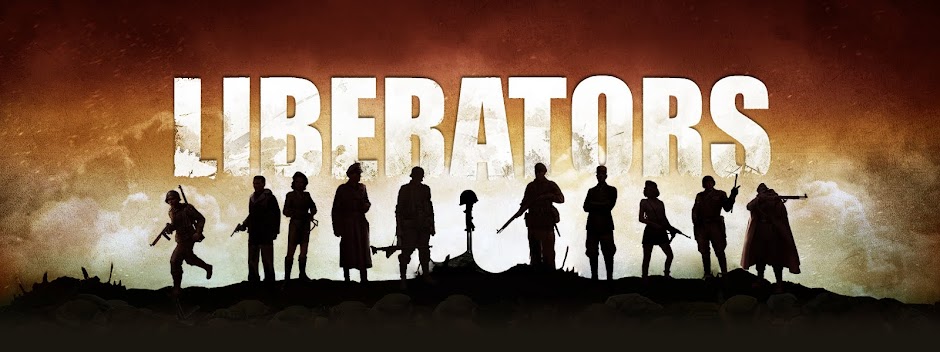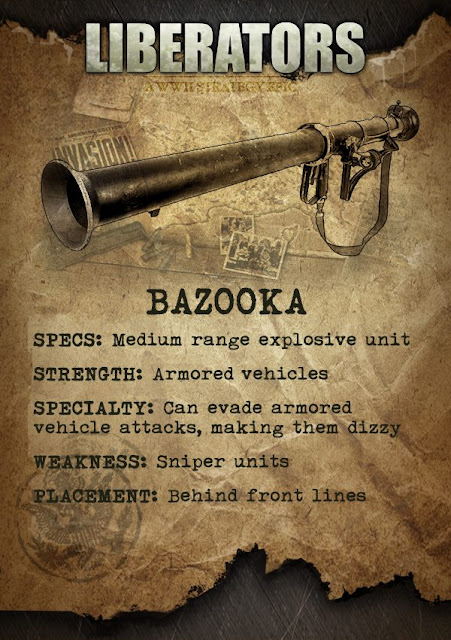Liberators features real-life weapons and equipment in World War II. Due to its ease-of-use, simple maintenance and operation, as well as fewer restraints on mass production, the M1 “Bazooka” became an indispensable tool for the war effort. Eisenhower cited the Bazooka as one of the major contributors to the Allied victory. It was useful against tanks and to assail fortified positions.
Bazooka is the common name for a man-portable recoilless antitank rocket launcher weapon, widely fielded by the United States Army. Also referred to as the "Stovepipe", the innovative bazooka was among the first generation of rocket-propelled anti-tank weapons used in infantry combat. Featuring a solid rocket motor for propulsion, it allowed for high-explosive anti-tank (HEAT) warheads to be delivered against armored vehicles, machine gun nests, and fortified bunkers at ranges beyond that of a standard thrown grenade or mine. The bazooka also fired a HESH round, effective against buildings and tank armor. The universally applied nickname arose from the M1 variant's vague resemblance to the musical instrument called a "bazooka" invented and popularized by 1930s U.S. comedian Bob Burns.
During World War II, German armed forces captured several bazookas in early North African and Eastern Front encounters and soon reverse engineered their own version, increasing the warhead diameter to 8.8 cm (among other minor changes) and widely issuing it as the Raketenpanzerbüchse "Panzerschreck" ("Tank terror").
The term "bazooka" still sees informal use as a generic term referring to any ground-to-ground shoulder-fired missile weapon (mainly rocket propelled grenades).
Secretly introduced through the Russian front and in November 1942 during Operation Torch, initial production versions of the launcher rocket M1 and M6 were hastily supplied to some of the US invading forces during the landing in North Africa. On the night before landing, General Dwight D. Eisenhower was shocked to find out from a subordinate that none of its troops had received any instruction in the use of the bazooka.
Initially supplied with M6 rocket highly reliable and untrained, the M1 did not play a significant armed role in combat in the North African struggle, but did provide a stroke of German intelligence when some were captured by the Germans in first encounters with inexperienced US troops . A US general visits ahead of Tunisia in 1943 after the end of combat operations could not find soldiers who could report that the gun had actually stopped an enemy tank. Another issue bazooka was suspended in May 1943.
During the Allied invasion of Sicily, a small number of M1A1 Bazooka (using an improved rocket, the M6A1) were used in combat by US forces. The M1A1 was responsible for four average German tanks and heavy Tiger I, with the latter being knocked out by an unlikely hit across the gap to the driver. A major drawback to the bazooka was the big backblast and smoke trail (in colder weather), which gave the position of the shooter, forcing rapid relocation of the squad. Furthermore, the bazooka fire staff often have to expose their body, in order to obtain a clear field of fire against an armored target. Casualties among the members of the bazooka team were extremely high during the war, and assignment of such rights in the face of German counterfire was generally regarded by other members of the squad not only as highly dangerous, but almost suicide.
When the existence of the bazooka was revealed to the American public official press release for the first two years stated that "packed the punch of a 155 mm cannon" -a great exaggeration, but widely accepted by the American public at the time.
At the end of 1942, the number of production early American M1 bazookas were captured by German troops of the Russian forces which received amounts of bazooka under Lend-Lease as well as during Operation Torch invasions in the North African Campaign. The Germans quickly developed its own version of the gun, increasing the diameter of the warhead of 60 mm to 88 mm (2.4 to 3.5 inches). In German service, the bazooka was popularly known as the Panzerschreck. The German weapon, with its larger warhead, more powerful, had significantly higher armor penetration; ironically, calls for a warhead larger diameter had also been raised by some officers of artillery during rehearsals US M1, but were rejected. After participating in an armor penetration test involving a German Panther tank using either Raketenpanzerbüchse or RPzB 54 Panzerschreck and bazooka US M9, the Donald E. Lewis cable from the US Army informed his superiors that the Panzerschreck was "far superior to American bazooka ":" I was so favorably impressed [by Panzerschreck] I was ready to take after the Krauts with his own weapon.
The bazooka M1 fared much better on the rare occasions that could be used against the much thinner armor usually mounted on the underside, top and bottom of enemy tanks. To hit the bottom panel of an enemy tank, bazooka operator had to wait until the tank was overcome a steep hill or other obstruction, to hit the top armor usually required fire the rocket from the top floor of a building or position high like. During 1944 Allied offensive in France, where some examples of connecting plane with the US Army began to be experimentally in armed camp, and were flying in pairs or quartets of American military equipment - and most notably used during the Battle of Arracourt - Major Charles "Bazooka Charlie" Carpenter assembled a battery of three bazookas M9 on the-fuselage wing brackets on either side of his L-4 Grasshopper aircraft in order to attack the enemy's armor, and was credited with six destruction tanks enemies, including two Tiger I heavy tanks.
Despite the introduction of bazooka M9 with its most powerful rocket, the M6A3-in late 1943, gun effectiveness of reports against enemy armor decreased alarmingly in the last stages of World War II, as new German tanks with thicker and better designed armor plate cast and armor skirts / armor spaced were introduced. This development has forced the operators to target bazooka less well protected areas of the vehicle, such as rails, sprockets, bogey wheels or rear engine compartment. In a letter dated May 20, 1944, General George S. Patton told a colleague that "the purpose of the bazooka is not to hunt tanks offensively, but to be used as a last resort to keep the tanks from invading infantry. to ensure this, the interval should be carried out at about 30 yards. " The extreme difficulty of closing the grenade-throwing unnoticed distances before hitting targets small spot on an enemy tank helps explain the high male death rate attributed to the duty to launch anti-tank rockets.
Campaign in the Pacific, and in North Africa, the original bazookas sent to combat reliability problems often had. The trigger circuit operates on battery was easily damaged during rough handling, and rocket engines often failed due to high temperatures and exposure to moisture, salt spray or humidity. With the introduction of the M1A1 and its most reliable rocket ammunition, the bazooka was effective against some fixed Japanese infantry positions such as bunkers of small arms and pill boxes concrete. Against emplacements coconut and sand, the weapon was not always effective, since these softer structures often reduced the force of impact of the warhead enough to prevent the detonation of the explosive charge. Later in the Pacific war, most infantry and marine units often used the flamethrower M2 to attack such placements. In the few cases in the Pacific, where the bazooka was used against tanks and armored vehicles, rocket warhead easily penetrated the thin armor plate used by the Japanese and destroyed the vehicle. Overall, the M1A1, M9 and M9A1 rocket launchers were seen as useful and effective weapons during World War II, although they were mainly used against enemy fortifications and fixed positions, not as anti-tank weapons. General Dwight Eisenhower later described it as one of four "tools of Victory", which won World War II for the Allies (in conjunction with the atomic bomb, Jeep and transport aircraft C-47 Skytrain).
Make use of it today on the battlefield now! Visit Liberators Facebook Page for more information!


No comments:
Post a Comment